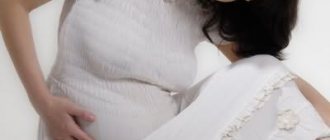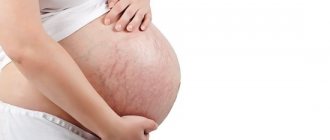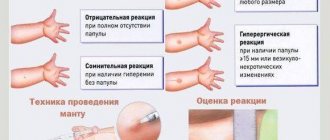Can a belly button come undone? Should we be afraid of such an outcome? In fact, such a phenomenon does not exist; this figurative expression denotes the occurrence of an external hernia in a person.
Therefore, the question of whether it is possible to untie an adult’s belly button amuses doctors and people who understand this topic. This popular expression dates back to ancient times, but even in ancient times it meant the occurrence of a hernia.
Can an adult or teenager's belly button come undone? If we interpret this question as “Is it likely that an adult will have an umbilical hernia?”, then the answer will be in the affirmative. With an unhealthy lifestyle, when a person moves little, has a sedentary job, abuses alcohol, eats a lot, and does not watch his weight, a hernia occurs in this area.
This disease is quite dangerous and can lead to negative consequences. At the first symptoms, you need to start treating this disease, taking preventive measures, and ideally, not allowing it to arise at all. Otherwise, you can easily provoke complications that will lead to no big troubles.
The most common type of complication of this disease is strangulation in the hernial heights. You can distinguish this disease by its characteristic symptoms:
- The pain will increase significantly at the site of the protrusion.
- The hernial protrusion will change color.
- It will no longer be possible to straighten it by hand, the hernia formation will harden and become more rigid.
- The patient is plagued by attacks of nausea or vomiting.
- Temperature fluctuations, general weakness, a feeling of depression and fatigue are possible.
So don't let your illness get the better of you. Strengthen your immune system and lead a healthy lifestyle. The best way to protect yourself from illnesses is to live an active, fun and interesting life. On our website you will find a video depicting a hernia, in cases where the “navel has come loose,” photos and numerous informational articles on this topic.
Where does the expression “the navel will untie” come from?
The expression “the navel will untie” literally means the occurrence of a defect in the abdomen, leading to severe pain
It is impossible to determine exactly who and when first began to use the concept of “the navel will be untied.” People apply this concept to situations like this:
- the person coughs heavily;
- someone lifts unbearable weights;
- a person performs actions that involve a large load on the abdominal muscles, including physical strain.
In these cases, you can hear: “your belly button will untie” or “you will tear your stomach.” Usually these phrases mean the same thing - the formation of a defect in the abdomen, which will lead to intense pain, like a back injury.
The common expression indicating an untied navel has a real medical term behind it - umbilical hernia. This is a serious disease that is most often found in newborns, pregnant women and the elderly.
How to speed up healing?
For speedy healing it is necessary to provide proper care. How to do it?
- After birth, the umbilical cord section itself is treated first with peroxide and then with potassium permanganate. Maybe iodine. This removes all blood clots and disinfects them. Although it is believed that if the cutting occurs after the pulsation has stopped, infection is unlikely. However, it is necessary to watch and process.
- Until the stump falls off, carry out the treatment once or twice a day. How? Yes, the same peroxide, and antiseptics include brilliant green, potassium permanganate (weak solution), chlorophyllipt, etc.
- Don't wrap up the baby! Provide air access to the umbilical remnant. There is an opinion that only air can heal a wound. No more processing. I do not share this position. I think that in such a case you need to insure yourself. After all, if anything happens, there is no one to blame except the parent. So disinfect, but don’t forget about air baths.
- Don't rub the umbilical cord. Use diapers with a special cutout. Or roll up the edges.
- Bathe (if you dare to do so) the first days after discharge only in boiled water.
As you can see, the main rule is careful attitude. The main thing is not to overdo it. After all, everything is good in moderation!
Tell us, how did your baby’s umbilical cord get cut? Or are you just studying this issue? If so, what are you leaning towards? Leave comments and become blog subscribers. Bye. See you again!
Source: my-happybaby.ru
Can a belly button actually come undone?
The navel is a vulnerable area of the human body, representing an opening connected to the abdominal wall. The navel appears after the umbilical cord dies and heals, which connects mother and child, being responsible for the latter’s nutrition.
Doctors point to the fact that the umbilical region remains the most vulnerable throughout life. Even the organ that is most susceptible to rupture and injury, the spleen, is very close to the navel.
The navel cannot simply “untie”, but weakness of the muscles in this area leads to the formation of a hernia. Externally, the protrusion may resemble the same state of an untied navel.
The pathology cannot be perceived as harmless, since when organs penetrate the hernial sac, the risk of strangulation increases significantly. And this can become a reason for complications in the future: peritonitis, necrosis of the intestine and other tissues.
Fistulas
Umbilical fistula is a connection between the umbilical ring and the small intestine or bladder. During the prenatal period, the fetus has choleretic and urinary embryonic ducts. Through the first, nutrition is supplied, and through the second, urine is excreted. Normally, they should close by the time of birth. In some babies, the ducts are partially or completely preserved. This is how fistulas are formed.
A complete fistula of the urinary duct leads to the fact that the navel becomes wet - urine is released through it. At the bottom you can see the red rim of the mucous membrane. An incomplete fistula is characterized by an accumulation of foul-smelling secretions and a change in skin color in the navel area - a pinkish spot may appear on it.
A complete fistula of the choleretic duct is accompanied by partial removal of intestinal contents and visualization of the mucous membrane. An incomplete fistula provokes serous-purulent discharge from the navel.
A fistula can be diagnosed based on examination, ultrasound and radiography. Treatment is only surgical. Without treatment, a fistula can cause omphalitis and peritonitis.
Causes of navel divergence in a newborn
In the maternity hospital, a medical clothespin is applied to the newborn baby, which then allows the correct navel to form. After about 7-10 days, the umbilical cord falls off along with the clothespin.
However, earlier, instead of a medical accessory, they used silk thread and tied the navel. This may have been the reason why the expression “the navel will come undone” then appeared.
Possible problems with a child’s navel are a much more realistic situation, similar to the symptoms of an “untied” navel. Since in the first weeks of a baby’s life this area is exposed to pathogenic flora, various diseases may develop:
- umbilical hernia - occurs due to muscle weakness, constipation, hysterical crying;
- omphalitis is an infectious and inflammatory lesion that develops due to improper wound care or very poor immunity;
- fistulas are dangerous disorders in which a hole in the navel is associated with improper healing of the intestines or ureter.
In some maternity hospitals, especially in small urban settlements or villages, navel ligation is still practiced. Cases where decoupling occurs are incredibly rare and occur once every 5-10 years.
Then the child begins to bleed heavily, which can only be stopped under medical conditions. Lack of help can lead to the death of the newborn. But in the practice of Russian doctors these are isolated cases.
A teenager's navel cannot be untied, just like an adult's. The only thing that threatens a child over the age of 10 years is a hernia due to excessive physical exertion.
Rules of care
In the maternity hospital, the baby’s umbilical wound is cared for by the medical staff; after discharge, this task falls on the mother’s shoulders. You should ask your doctor or nurse about how to clean your belly button during the first month of life.
Care stages:
- Bathe the baby in a separate bath in boiled water (36-37 °C). You can add a weak solution of potassium permanganate or an infusion of herbs with antiseptic properties (chamomile, chamomile).
- After water procedures, blot the baby’s skin with a terry towel. The abdominal area should not be rubbed.
- Using clean fingers, gently spread the skin near the navel and drop a little hydrogen peroxide on it. After waiting until the reaction (hissing) stops, blot the remaining product with cotton wool.
- Soak a cotton swab in brilliant green and apply it to the umbilical wound.
Manipulations must be carried out carefully: when trying to clean the navel, it is unacceptable to pick, rub, or press on it. If there are yellowish crusts inside, you should pour peroxide on the wound, wait 2-3 minutes, and they will be removed.
Many modern experts believe that the navel does not need to be cleaned with antiseptics. Bathing your baby in boiled water every day is enough.
In any case, it is important to ensure constant access of air to the wound: do not cover it with a diaper and arrange air baths more often. Until the navel heals, the baby should not be placed on his stomach and massaged.
With improper care, as well as for other reasons, various problems can arise. Most often, young mothers are worried that the navel does not heal for a long time, becomes wet, inflamed, bleeds, bulges, changes its color to red, brown or blue. Let's figure out why this happens.
Can the belly button come undone during pregnancy?
Changing the shape of the navel during pregnancy
While carrying a child, a woman’s body faces enormous stress. The rectus and oblique abdominal muscles are greatly stretched and lose tone. If there is weakness or congenital dysplasia, an umbilical hernia may appear.
But do not confuse a slight stretching and protruding of the navel with a disease. To clarify the diagnosis, be sure to undergo examination by a gynecologist and surgeon. In most cases, surgery is not required. There are also situations when a hernia forms after childbirth as a result of an intense decrease in the volume of the abdomen. Then doctors prescribe elective surgery, but not earlier than 6 months after birth.
Principles of massage
Massage will help cure a small protrusion in the navel area. It is advisable that the course of procedures be carried out by a specialist. But if this is not possible, then you can massage the baby yourself after the umbilical wound has healed.
Sequencing:
- Stroke the abdomen with your palm around the navel, without touching the liver area.
- Bend the index finger of your right hand and move its second phalanx around the navel 2-5 times.
- Place the pad of your thumb on the navel and lightly press on it, imitating screwing movements 3-5 times.
- Tap your stomach with your fingertips.
- Place the palms of both hands under the child's lower back. Use your thumbs to move along the oblique muscles and connect them above the navel.
Massage helps to train the abdominal muscles and increase their tone. It must be carried out before meals, with the child lying on his back on a flat surface. Abdominal massage is done only clockwise.
Symptoms of an umbilical hernia
The structure and external manifestation of umbilical hernias
If the navel of an adult is untied, that is, a hernia has formed, vivid symptoms arise. Conventionally, a hernia can be divided into simple and strangulated. In the first case, only one striking sign appears - a noticeable tumor formation in the umbilical zone.
The hernia will be mobile, disappearing when the person takes a supine position. The smaller it is, the more active it appears against the background of coughing, straining and physical activity. Also, after sports, discomfort and even pain appear in the navel area.
If the hernia increases in size, there is a risk of complications. With large protrusions, organs can get inside the sac. When pinched, the following signs appear:
- acute pain in the affected area;
- the skin around the bulge becomes red, swollen, or bluish;
- the hernia does not reduce in a supine position, becomes less mobile and more rigid;
Strangulated hernia - the patient may experience vomiting, severe nausea, bloating and signs of intestinal obstruction;
- the temperature rises, the patient experiences acute weakness, apathy, and finds it difficult to move.
The symptoms of strangulation in children are similar, as is the mechanism of hernia development. However, the baby cannot verbally describe what is happening to him.
Parents should be alert to the following signs: redness in the area where the navel protrudes, the baby’s crying, irritability, and active movement of the legs. Newborns spit up frequently and often refuse to eat.
Umbilical hernia is easily diagnosed in both adults and children.
Other problems
What other problems can arise with a baby's navel? The most common situations:
- The wound is bleeding, a bruise (dark spot) has appeared - injury occurred due to careless hygienic manipulations, when putting on a diaper or clothes, or when turning over on the stomach. You can clean the wound with peroxide and treat it with an antiseptic. If the navel does not heal and bleeds continuously, you need to consult a doctor.
- The navel becomes wet - a foreign body has entered it. It is necessary to visit a pediatric surgeon to have it removed.
- The navel is red, but not inflamed - the baby “studied” his body and injured the skin. This often occurs at 6-10 months. Another cause of redness is food or contact allergies. In this case, a rash will be present on other parts of the body.
The navel is one of the most vulnerable areas on a baby’s body in the first month of life. Normally, the wound heals within 1-3 weeks. During this period, it must be cleaned very carefully to prevent infection. If your baby's belly button is inflamed, bleeding, bulging or wet, you should show it to the doctor. In most cases, problems can be solved by massage and proper care.
Source: ogrudnichke.ru










